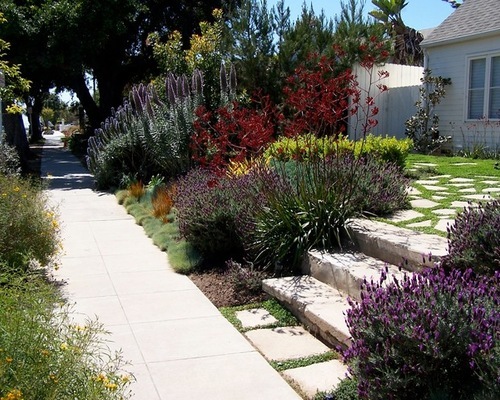I’ve met with more than one client while standing on a struggling lawn. “I keep trying,” they tell me, “but the grass won’t grow.” I tell them that maybe this means there’s another option, something even better than a lawn. Maybe it’s time for a garden. And it’s as if I’d just told them the secret to eternal happiness and long life.
Still Have Hope for Greener Grass? Ask a Lawn Professional
Don’t keep tossing grass seed on your bare lawn. Instead, put a garden there, or at least plant something that has a better chance of surviving. Here are three situations where a languishing lawn may call for a new vision — a self-supporting garden that wildlife will love to call home.

BE Landscape Design, original photo on Houzz
1. Blazing sun. Whether it’s out in the open on a flat grade, on a slope or atop a hill, lawn just never does well in hot sunshine. It burns away each August, opening up holes for advantageous weeds to move in.
You could seed or plant drought-tolerant native grasses like sideoats grama and blue grama (Bouteloua curtipendula and B. gracilis) and little bluestem (Schizachyrium scoparium). Or try sedges like shortbeak and Bicknell’s (Carex brevior and C. bicknellii). And while you’re at it, get some flowers. If it’s a larger area, think self-sowers like upright prairie coneflower (Ratibida columnifera), black-eyed Susan (Rudbeckia hirta) and skyblue aster (Symphyotrichum oolentangiense). For smaller areas, ‘October Skies’ aromatic aster (S. oblongifolium ‘October Skies’) works well, along with pale purple coneflower (Echinacea pallida), purple and white prairie clover (Dalea purpurea and D. candida), many species of Baptisia, and more.
Try to create a base layer of sedges and grasses that will work to mulch and cool the soil, adding clumps or drifts of flowers among them for seasonal interest and pollinator action.
Attract Pollinators for a Productive Edible Garden

Anne Roberts Gardens, Inc., original photo on Houzz
2. Ponding water. After a heavy — or even moderate — rain, water may collect in an area of your lawn, drowning grass for days or even weeks. When that water finally vanishes, you’re left with barren soil that’s both unsightly and open to weed invasion.
This sounds like an area where rain garden plants may work. These are the plants that thrive in the boom-bust cycle of spring and fall flooding with dry summers. Swamp milkweed (Asclepias incarnata), Virginia mountain mint (Pycnanthemum virginianum), Joe Pye weed (Eutrochium purpureum), switchgrass (Panicum virgatum), muskingum sedge and fox sedge (Carex muskingumensis and C. vulpinoidea), New England aster (Symphyotrichum novae-angliae), queen of the prairie (Filipendula rubra), white turtlehead (Chelone glabra), and Culver’s root (Veronicastrum virginicum) are all good options.
If it’s a large area and you want privacy, a shrub hedgerow is an option. Plant redtwig dogwood (Cornus sericea), red or black chokeberry (Aronia arbutifolia and A. melanocarpa), or elderberry (Sambuca sp.) — they will slowly sucker to form a massive bird and native bee habitat.

Sisson Landscapes, original photo on Houzz
3. Dark or dappled shade beneath a tree. Trees are great: They cool homes, clean the air and provide for so much wildlife. Oaks (Quercus spp.), maples (Acer spp.), elms (Ulmus spp.) and willows (Salix spp.) are near the top in serving a diversity of pollinators and other insects, specifically, that use the leaves and blooms at different life stages. But grass doesn’t often grow underneath these tall trees — mostly because they cast dense shade.
If you have rich, moist to medium soil, there are many spring ephemerals to choose from: Dutchman’s breeches (Dicentra cucullaria), trillium (Trillium spp.), shooting star (Dodecatheon meadia), yellow trout-lily (Erythronium rostratum) and Virginia bluebells (Mertensia virginica).
For gardeners with dry clay soil, early meadow-rue (Thalictrum dioicum), zigzag goldenrod (Solidago flexicaulis), calico aster (Symphyotrichum lateriflorum) and wild geranium (Geranium maculatum) are solid choices. Sprengel’s sedge (Carex sprengelii) is a grass-like option.
If you don’t want a large bed of strictly plants, weave a path of mulch or stepping stones through. Place a chair or two, a hammock, or a potting bench.

The Philbin Group Landscape Architecture, original photo on Houzz
It’s always important to carefully research the plants before you buy them to make sure that they suit your conditions. Clay soil is different from sand or rocky loam, and while some plants may do well in several kinds of soil and light conditions, others won’t. You may also prefer plants that create short drifts rather than tall ones, or vice versa, or clumping plants instead of aggressive spreaders.
When you take the time to carefully match the plant to the site and your region, you’re setting yourself up for more success and beauty with less maintenance — unlike sowing grass seed over the same area year after year.
 Facebook
Facebook
 X
X
 Pinterest
Pinterest
 Copy Link
Copy Link
